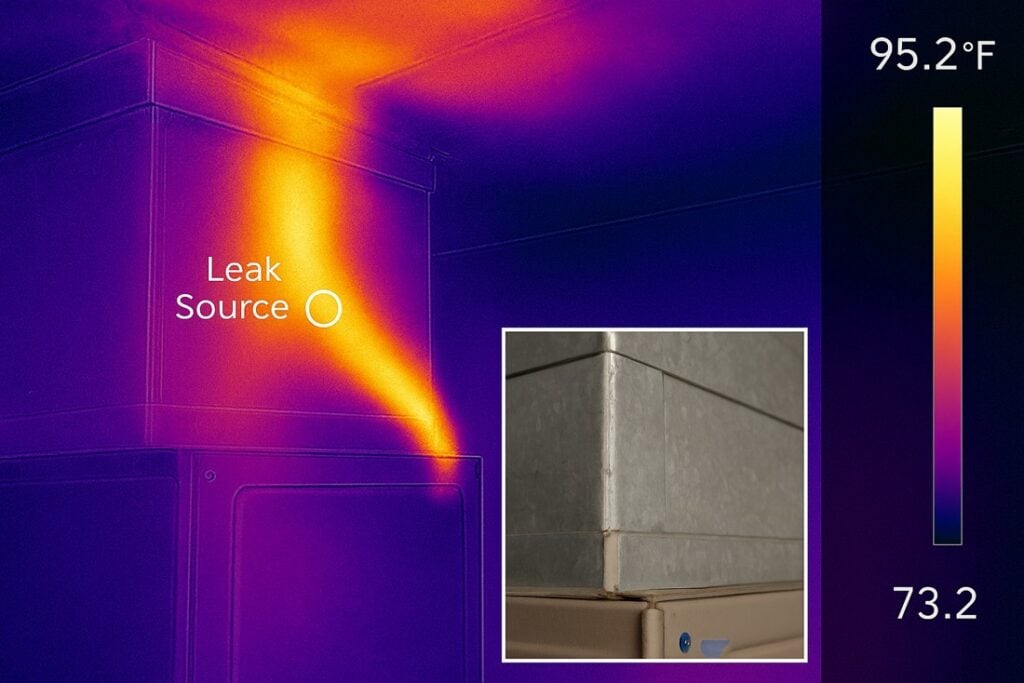Blog
Return Duct Sealing: Stop Dust And Hot Spots

If rooms feel dusty, weak, or warmer than the thermostat setting, the problem may be your return side. Leaks on the return pull attic air and fine insulation fibers into the system, starve the blower, and leave bedrooms short on supply. Return duct sealing targets the biggest hidden leak in many Florida homes, and it often delivers faster comfort gains than chasing a larger AC.
Why return leaks create dust and uneven rooms
The return is the system’s intake. When seams at the plenum, panned returns, or filter rack do not seal, the blower makes up the difference by sucking air from the attic or wall cavities. That air carries dust, humidity, and heat. The coil gets dirty sooner, the drain pan sees more debris, and your living spaces inherit the extra load. In practice, you feel weaker airflow at distant vents and a haze of dust near the return grille. Sealing the return raises delivered airflow, trims dust at the vents, and helps the coil stay clean so cooling cycles remove moisture the way they should.
Signs you need return duct sealing right now
Look at the metal around the return plenum and filter rack. Gray streaks or powdery rings around seams point to leakage. Tissue that flutters inward near a seam while the system runs is another simple clue. A door that is hard to close when the system is on hints at negative pressure from a starved return. If you replace filters on time but still see dust on furniture soon after cleaning, return air may be bypassing the filter entirely. Any of these signs suggest that sealing will pay off quickly.
What proper return duct sealing includes
A solid return duct sealing visit starts with a short static pressure check at the return plenum to confirm the blower is working too hard. Next, seams are cleaned and sealed with fiber reinforced mastic, not ordinary tape that dries out. Joints at the filter rack are tightened and a tight fitting door or cover is installed so the filter actually filters. If the return is undersized, a second return or a jump path can be added to reduce noise and improve airflow to closed bedrooms. After sealing, static pressure is measured again to show the improvement. You should also feel the difference at the vents without pushing the thermostat colder.
FL-Air handles each of these steps, then wipes the coil lip and pan edge so loose dust does not re enter the drain line. If your coil is already matted, our team can clean it and verify a clear drain before we close up the return.
Why cooler months are the best time to seal
Attic work goes faster in cooler weather, which means better pricing and cleaner results. Seams accept mastic more evenly, crews can spend more time on detail, and your system can be tested under a calm load without summer extremes. You also set yourself up for spring by fixing the bottlenecks that make the AC run long and hard in May and June. Many homeowners pair sealing with a quick duct evaluation so the whole path from return to supply gets a once over before the heat returns.
How sealing helps the rest of your system
Tight returns reduce dust that coats the coil, which helps the system hold temperature and humidity. Better airflow also lowers strain on the blower motor and helps the outdoor condenser run at normal head pressure during hot afternoons. With fewer leaks, the filter does its job, so indoor air feels cleaner and the drain pan stays clearer. If you have had a float switch trip in the past, sealing and a light coil cleaning can cut down on slime and prevent repeat shutdowns. If electrical parts have struggled after storms, improved airflow pairs well with surge protection at the disconnect to keep nuisance failures away.
A quick look at process and proof
During return duct sealing, the technician will photograph the before and after seam conditions and log the return static pressure both times. You should see a lower negative pressure number after the work, which means the blower is breathing easier. A short walkthrough at key rooms confirms a stronger feel at the supply registers. If a room still lags, the issue may be a crushed branch or a small boot gap at the ceiling. FL-Air can spot fix those items and balance airflow so temperatures land even through the home.
When sealing is not enough
If the return box is rusted, the plenum is undersized, or the filter rack door cannot be made tight, sealing helps but does not solve everything. In those cases, a modest return upgrade or a replacement plenum makes sense. The goal is the same either way. Give the blower an easy path, stop dust from bypassing the filter, and deliver steady airflow to each room. FL-Air can quote the simple sealing you need or show you the cost and benefit of a small upgrade when it pays back better.
Simple habits that protect your investment
Seat the filter door fully after every change so the filter captures air instead of letting it slip around the frame. Keep a clear path to the return grille and avoid blocking nearby space with furniture or storage. Use Fan Auto at the thermostat so moisture drains between cycles. If you notice tissue movement at a seam again, call for a quick check before dust builds on the coil. Small attention now keeps the gains you bought with sealing.
Contact FL-Air Heating & Cooling
Ready to tighten the system and cut the dust at the source. Call 813-800-2665 to schedule return duct sealing with a free estimate while attics are cooler. Our team will seal the seams, fix the filter rack, verify airflow with numbers, and balance rooms so your home feels even again.








